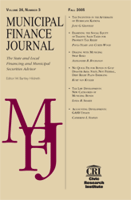Does Intrastate Competition in Segmented Municipal Bond Markets Affect Interest Costs? An Empirical Test of the Preferred Habitat Hypothesis
Author: Robert A. Greer.; Dwight V. Denison.
Source: Volume 35, Number 02, Summer 2014 , pp.1-15(15)

next article > |return to table of contents
Abstract:
When markets are efficient, municipal bonds with comparable issue and risk characteristics should sell at similar interest costs. The literature on bond markets suggests that municipal markets are segmented through a state’s income tax exemption for municipal bond interest. An alternative explanation of regional market segmentation, a preferred habitat hypothesis, asserts that information costs and personal preferences influence preferences to buy local debt over otherwise equal tax-exempt debt. To empirically test the preferred habitat hypothesis, we estimate several models of true interest cost for county governments in Texas, where there is no state income tax. Empirical analysis demonstrates that even correcting for possible endogeneity, the Texas visible supply increases tax-exempt interest costs of Texas county issuers more than the U.S. visible supply. These findings suggest evidence in support of the preferred habitat hypothesis.Keywords: Preferred habitat, market segmentation, municipal bonds, visible supply
Affiliations:
1: University of Georgia; 2: University of Kentucky.